Delightfully, our last few days have been a bit more laid-back than the average for this trip, so two days have gone by and I don't feel overwhelmed by all the events that I have to tell you. We left the Loire Valley late yesterday morning and headed south, arriving at our vineyard-slash-bed and breakfast early in the afternoon. It's a beautiful place, a 16th-century miniature castle nestled among rolling hills of grapes, just north of Bordeaux. As you drive over the crest of a hill, this view meets your gaze:
The remainder of the experience is as pretty and restful as that sight would indicate. The owners here are the fourth-generation owners of this vineyard on the husband's side. Our room is in the remodeled side tower, with the modern bathroom actually maintaining the round shape of the tower as well as its narrow, archery-friendly windows.
We were in need of a rest, so apart from going out for a casual dinner last night, and a cellar tour and quick market trip this morning, we spent the last few days just lazing about the property. The air smells delicious, the view is spectacular and the water tastes great: what more could we ask? There are even cats.
I've actually been getting a little reading time in over the last two days, which has come to seem like a great luxury—I've barely read a page for the last two weeks, and I'm starting to feel a bit twitchy. I've been enjoying one of the books I picked up in Bayeux, Carola Hicks's The Bayeux Tapestry: The Life Story of a Masterpiece. Hicks gives an overview of the Tapestry itself, followed by a chapter about the theories on who could have commissioned the piece, and another on the probable methods of its production. Lots of interesting stuff, including the answers to a couple of questions y'all asked about the Tapestry. I hope you really wanted to know, because here you go!
Stefanie (I think? though now I can't find the comment) wanted to know if it was made by women, and the answer is probably yes. It's likely that women did the actual embroidery—probably English women, and likely nuns living together in a convent. Apparently there were several convents in England that sported highly accomplished embroidery workshops capable of taking on this kind of project. The overall drawing or design would have been created by a man, though, most likely a monk or someone with monastic training, who was familiar with the illuminated manuscripts of the day (the Tapestry borrows a lot of imagery from illumination conventions). The designer is likely to have supervised the whole project, and most of the embroidering would have been done to his strict instructions. Interestingly, the only place in the tapestry where the embroiderers were likely free to express their individual styles, was in the foliage found between the diagonal lines in the upper and lower registers. From the variation in styles along the length of the Tapestry, it seems likely that the designer merely told the women to stitch in some kind of leafy ornament, without getting too specific.
Actually, Hicks brings up the possibility that the Tapestry could even have been commissioned by a woman, rather than by Bishop Odo as generally thought. Edith Godwinson was the widow of Edward the Confessor (whose death sparked the whole struggle for rule of England), and sister-in-law to Harold (his designated heir and the loser at the Battle of Hastings). Hicks points out that Edith was a savvy politician who, very unusually, managed to keep her estates and most of her fortune after the Norman conquest; that, as queen, she had control of one of the most accomplished embroidery workshops in England; that she had previous experience commissioning a piece of propaganda designed to position her family members strategically with the King; and that her attitude toward the invasion, that of an English woman sympathetic to Harold but who nonetheless accepted the validity of the Conquest, would explain the Tapestry's many ambiguities regarding which side had the moral high ground.
Anne was interested in where the Tapestry was made and its use after construction, neither of which are known for sure. As I said, it was probably made in England, where William's court was spending most of its time in those early, contentious days after the Conquest, when rebellions were breaking out all over the countryside. The Tapestry's small size top to bottom means it was likely intended to be viewed at eye level, most likely in the great hall at William's court, where it would flatter the Normans who were involved in the battle, prop up the validity of the court, and impress visitors. But very little is known about what happened to it during the next 300 years, and how it ended up in Bayeux Cathedral in 1476, when it was included in an inventory of that cathedral's possessions. By the late 15th century its use had changed: it was being hung around the top of the nave for just over a week every year in July, to celebrate the feast of the relics on which Harold swore his oath to William. Of course, nobody in the congregation would have been able to see it properly so high up, and none of the church officials seemed very interested in the thing. Nevertheless, they continued to hang it in the nave every year in July, and were still doing so in the early 18th century, when a priest told an interested antiquarian that the annual hanging was in order to air the tapestry out. Essentially, they'd forgotten the original reason for the tradition and were just carrying on out of habit.
Hicks goes on to trace the later history of the Tapestry: its rediscovery by 18th-century antiquarians, the lucky coincidences that allowed it to survive the French Revolution, its use by Napoleon to justify his own invasion of England in the early 19th century, and so on. Although I'm finding this section interesting as well, what I'd really like is more "close reading" of the Tapestry itself, of its details and ambiguities. Hicks may get back to these questions in later chapters, and I'm also hopeful that the other book I bought (which is in French, and focuses on the Tapestry as a Viking chronicle) might scratch that particular itch. In the meantime, the information in Hicks's book about the manner of the Tapestry's construction was well worth the price of admission all by itself.
Our only other major activity over the past few days, beyond napping, reading, and gazing out over the vineyards, was to tour the cellars and vineyards with the other B&B guests. Philippe, our host, led the tour in French, and I understood quite a bit although there was also a lot that slipped past me. The information I did pick up was pretty interesting. Philippe's great-grandparents bought the property, which is in the Côtes de Bourg appellation, north of Bordeaux. French winemaking is highly regulated, and each appellation is limited in the varieties of grape they are allowed to grow. (I think this is something that strikes Americans as bizarre and overly restrictive of our FREEDOM, MAN, but it means that wine from a particular regions will have a generally predictable character, similar to how New World wines are bottled by grape variety.) In the Saumur region of the Loire Valley where we just came from, for example, all the red wine is Cabernet Franc, which happens to be one of David and my favorite grapes. Down here, in this particular appellation, Philippe's reds are blends of Cabernet Sauvignon, Merlot and Malbec grapes, while his whites are Semillon and something else I can't remember. He made the interesting point that if a French winemaker wants to grow a different type of grape ("like they do in the United States," he added) they're free to do so, but any wine from non-approved grape varieties will be bottled as plain table wine, not as the more lucrative and respected fine wines marked with the name of the appellation. Which means it's obviously not a great business decision for the vintners, but it also made me wonder if there's some interesting experimentation going on in the world of table wine production.
There was a hilarious, garrulous older Frenchman on the tour, who asked a lot of questions and aggressively voiced his opinions, sometimes actually shaking his finger at Philippe, although never, despite appearances, actually getting angry. He was just very enthusiastic and invested in every subject that came up. Philippe mentioned that they've been having a drought this year, but that because his vines are quite old, with deep, well-established root systems (some over 60 years old), they're still in pretty good shape. The garrulous Frenchman asked about people speculating on good and bad vintages, and Philippe said that wasn't a big problem because it is somehow controlled, but I didn't catch the finer points. Philippe also talked about his harvesting practices; his harvesting is now done by machine, and the garrulous man had a lot of questions about whether the quality of grape harvests by machine are inferior to hand harvesting. Phillippe answered that there was no noticeable difference; when they first got the machine they did a trial between machine-harvested batches and hand-harvested, and were satisfied with the work of the machine. The garrulous man and Philippe then got into a conversation about how expensive the harvesting machine was, and how capital investments are necessary but burdensome for small businesses. The man then wanted very much to see this famous machine, but unfortunately it was out for repairs prior to the fall harvest.
Philippe showed us the machine that skins and de-stems the grapes and sorts them from their attendant refuse. (This was in a barn with a small hole for the swallows to enter and nest, and suddenly the garrulous man was very intense about swallows. "They're amazing!" he exclaimed. "Every single year, they return to the same place. Generation after generation! Formidable!") We then saw the barrels and heard about the importance of continual tasting during the maturation process, to determine how the wines are shaping up and whether any controls on the temperature or other factors are necessary. Philippe said that he sometimes tastes the wines as often as every day. I noticed that the barrels were labeled "Mendocino," and managed to ask a semi-intelligent question about whether their wines are oaked in French or American oak. Philippe said it depended on the wine: their whites and roses are oaked in American, but their reds in French oak. The garrulous man then demanded whether the American barrels were made from American Oak grown in France, and a whole animated conversation ensued on that subject, with much hand gesturing and the general answer that no, the American oak barrels were imported from California.
We went back outside and looked at the actual vines, with the garrulous man wanting to know the whole story about how the vines are staked an espaliered, which is done by hand here in the winter. The particular vines we were looking at were 15-year-old Merlot, and Philippe mentioned (at a question from the garrulous man) that their main roots are about nine meters deep—part of what helps them withstand drought. Finally, we did a little tasting of the six or so wines produced here, which include a fairly fruity (what I think of as "merlot-y") red and a more tannic/Old World one (both 2007/2008); another red that's older and is almost like a port (2002); a very nice rose which struck me as the most interesting and unusual, kind of "condensed" feeling, and with nice peachy flavors that weren't over-sweet at all (2010); and an oaky white that tasted pretty similar to something from Napa (2010). The garrulous man kept exclaiming at the overly generous pours, and at one point insisted on giving his glass to David ("You have come from a long distance! You must get a good impression of France—and the French!") So there you go, our adventures in wine country. The whole experience was really fun, and had me wondering why we never go check out the vineyards near home, especially since Oregon is pretty much the Pinot Noir capital of the country.
Fittingly, for a day we're staying in a castle, there was a great thunder and lightning storm this afternoon, and the grapes finally got a little water. It was lovely to smell the fresh, cooler air drift in from the vineyard after the huge echoing claps of thunder and flashes of lightning had abated. Tomorrow, we're on to our friends' house in Toulouse, with a stop at the former home of my old buddy Michel de Montaigne. PS: Argh, I have no idea why excerpts from some of these entries are appearing above the header, and I don't have time to sort it out now. Sorry about that!
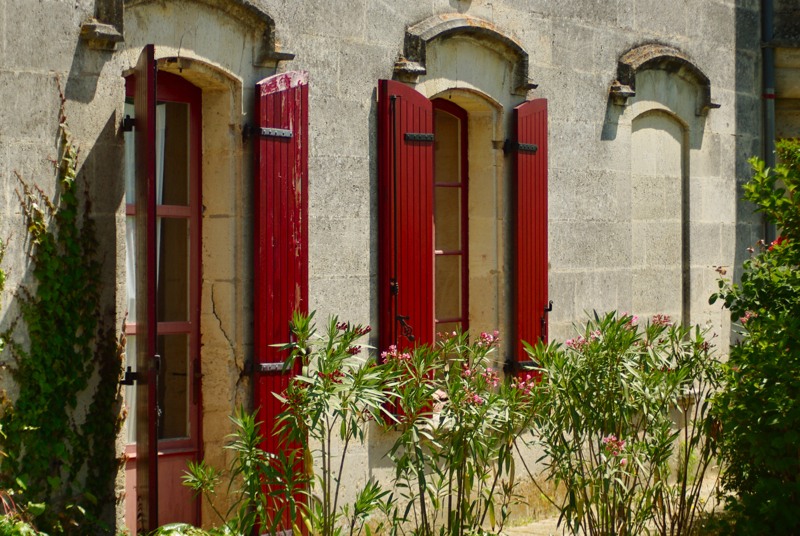
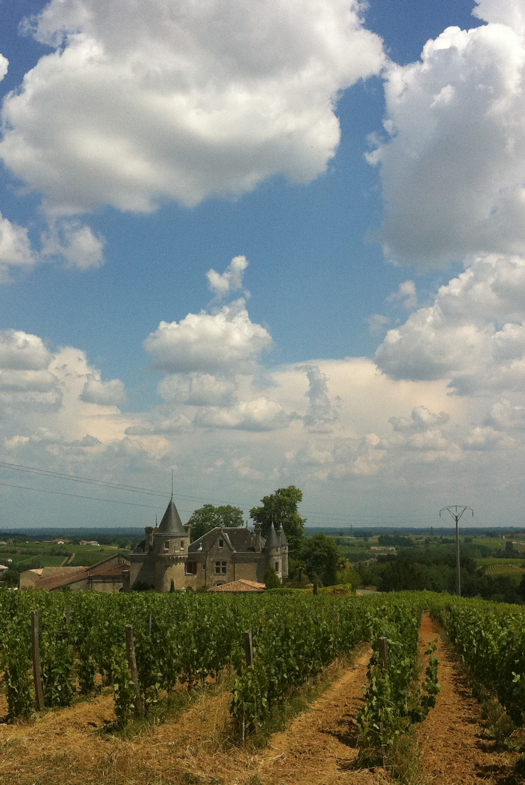
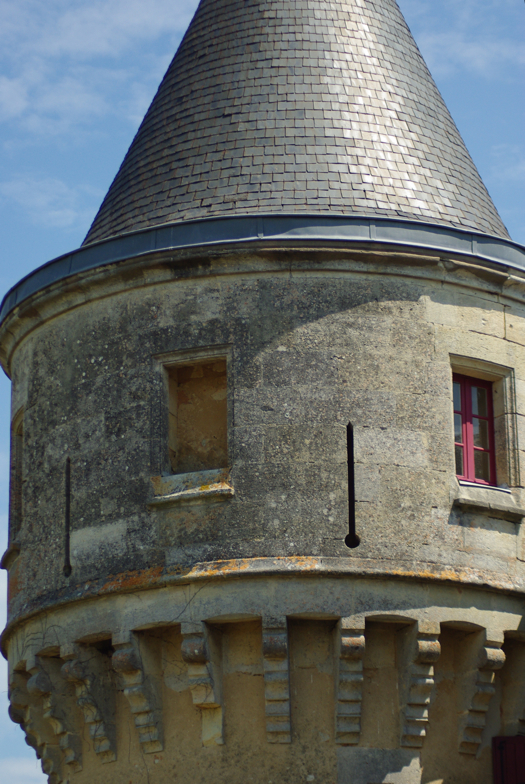
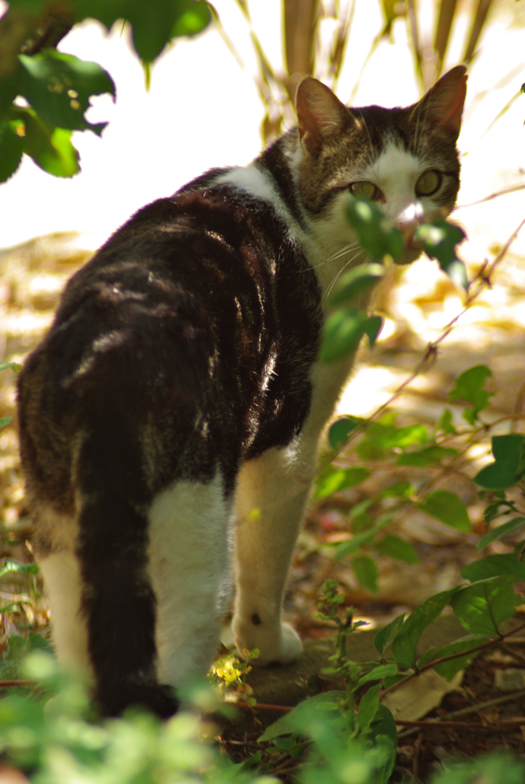
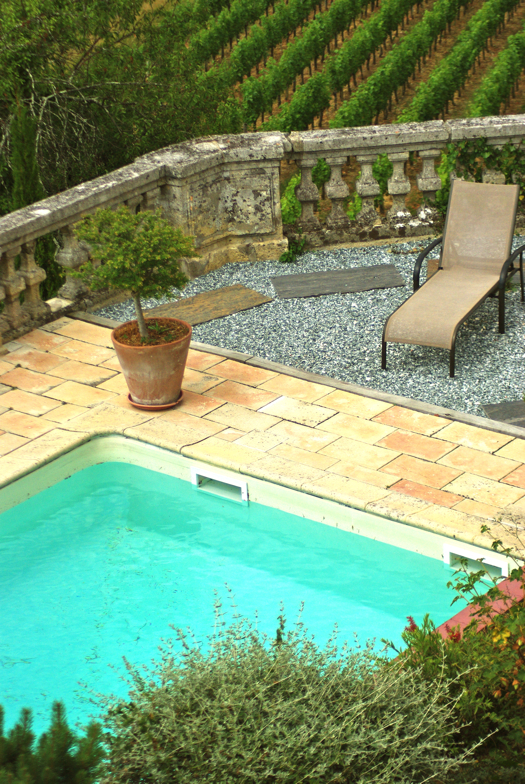
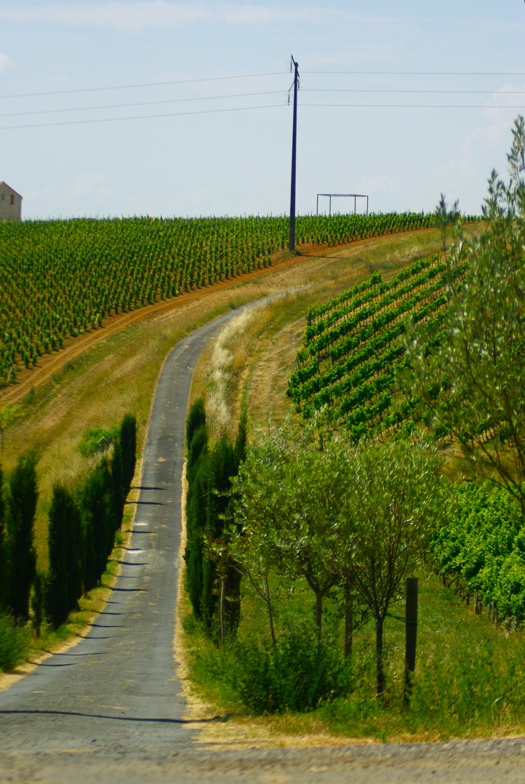


A "travel cat" - as if by magic! Thanks for the very interesting resumé of the book on the Bayeux tapestry. It seems to me that modern stereotypes about women's traditional place in the world has led us to see medieval society very unimaginatively - there were quite a few powerful women at that time. Your tour of the winery and your stay at the chateau (with "archery-friendly windows" - I shall remember that phrase if ever we need to sell our flat in Aberdeen!!)look perfect. I'm so pleased that your trip has gone so well for you, and thanks for sharing it all so generously with us.
Yes, I love the travel animals! And I agree that it's always fascinating to see our preconceptions about women during medieval and other oppressive periods questioned and/or deepened. I am now curious to learn more about Edith Godwinson, who sounds like she was quite a survivor and a smart/ruthless woman, in addition to living in some very tumultuous times.
I am jealous. Honestly, I don't think I would spend much time leaving your lovely tower room.
I saw the Bayeux tapestry several years ago and was very impressed with it. It's a marvel, although I did think the actual stitchery (is that even a word) on it was quite coarse. I was expecting very fine needlework, which I did not find. But when you have 1000 year old embroidery in front of you, you can't be too picky.
I remember getting quite a different story about it than the one the book you're reading tells. We were told the tapestry was made by monks in and English monastery and late displayed in the church at Bayeux on an annual basis and at a level low enough to view from the floor. It's interesting to see that the story has changed. History never stays the same for long, I guess.
It is so interesting to see how the current version of history morphs over time, I agree. The annual hanging in Bayeux Cathedral that you mention definitely happened, from at least the 15th century, but Hicks argues that it wasn't the method of display originally intended. (Mostly because of the tapestry's size, but also because it wouldn't necessarily have reached the right eyes at court & convinced the right powerful people). As for the monks versus the nuns, I'm betting nobody really knows for sure. Hicks spends a lot of time exploring / arguing for the idea that Edith Godwinson commissioned the Tapestry, and Edith would have had nuns rather than monks at her disposal. So maybe that's why she (Hicks) privileges the idea that the embroiderers were nuns. It was almost certainly a monk who designed it, and Hicks cites another large-scale embroidery project from 1330 that had both male and female embroiderers (with the men earning about a third more than the women). So interesting.
I agree that the stitching itself is not what we've come to think of as "fine" embroidery. But to me the coarseness of the stitching actually suits the violent subject matter. Surprisingly affecting, I thought!
What a beautiful place you stayed at! Thanks for the information about the Bayeux tapestry. fascinating! I can't wait to hear about your visit to Montaigne's home!
Montaigne's house was really interesting! I'll try to write it up tonight. And yes, the vineyard was super pretty. Every place we stay, it's hard to leave! :-)